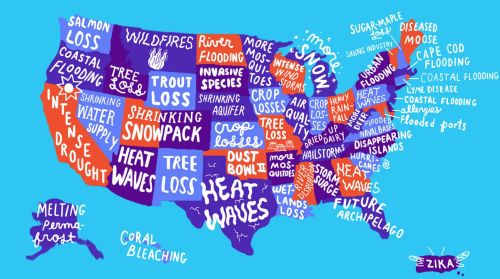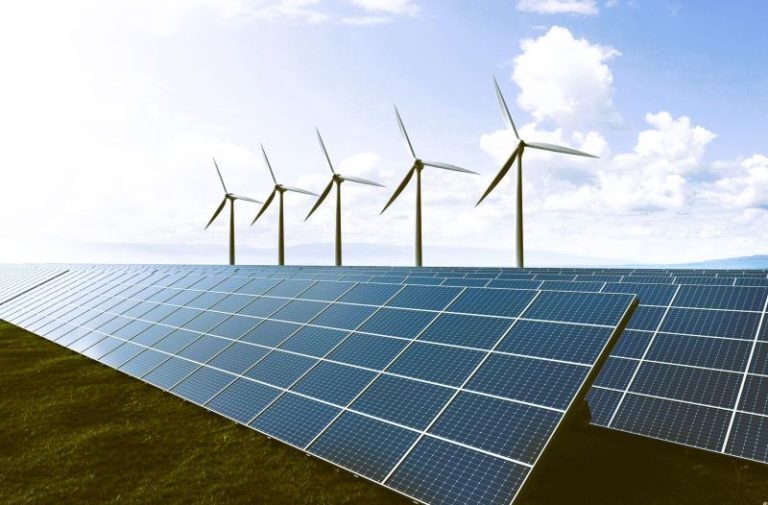

The Trump administration’s decision to slash billions in clean-energy funding is more than a policy dispute; it is a stress test for the balance between politics, law, and governance.

By Matthew A. McIntosh
Public Historian
Brewminate
Introduction
The Trump administration has moved to cancel nearly $8 billion in clean-energy projects, a decision that overwhelmingly affects states that voted for Kamala Harris in the 2024 election. The cuts (which span hydrogen hubs, solar deployments, and grid modernization efforts) were announced this week as part of a sweeping rollback of climate initiatives, and they fall almost entirely on blue states such as California, New York, and Minnesota. Critics have branded the move political retribution, arguing that the administration is punishing regions aligned with Trump’s former opponent while jeopardizing thousands of jobs and billions in private investment.
The cancellations were spearheaded by Trump budget chief Russ Vought, who framed the action as cutting “wasteful green subsidies.” But the numbers tell a different story: the bulk of the halted projects were already underway, and many had secured state and private-sector matching funds. Local officials warn that the sudden withdrawals will devastate clean-tech industries that have become economic anchors in their communities.
The decision has sparked immediate backlash. Governors in the affected states are threatening lawsuits, pointing to the Impoundment Control Act of 1974, which limits a president’s power to withhold congressionally appropriated funds. Legal scholars say the selective targeting of opposition states raises serious constitutional questions. Meanwhile, energy companies and investors caution that the uncertainty will chill innovation and push America further behind global competitors in the race for renewable energy.
What emerges is not just a debate over energy policy, but a test of whether federal resources can be deployed as a political weapon and whether the courts will step in to draw the line.
The Facts and Numbers
The scope of the cuts is staggering. The Trump administration’s decision eliminated 223 clean-energy projects across 16 states, wiping out nearly $7.6 billion in federal support. In California alone, the ARCHES hydrogen hub lost $1.2 billion, money that had been earmarked to accelerate development of renewable hydrogen as a fuel source. Other projects, ranging from large-scale solar installations in Arizona to grid resilience upgrades in New York, were also abruptly halted.
While the cuts were justified by Trump budget chief Russ Vought as eliminating “non-viable” or “wasteful” spending, the pattern reveals a starkly partisan edge. All of the states hit hardest voted for Kamala Harris in the 2024 election. The only exceptions were small crosscurrents: in California’s Republican-leaning Central Valley, some local communities will also lose projects tied to grid modernization, showing that even red enclaves inside blue states are caught in the crossfire.
In Connecticut, CT Insider detailed how 12 projects worth $52.9 million were suddenly cut, including work at the University of Connecticut and FuelCell Energy, both of which were deep into their research and deployment phases. “This is not just a line item; these are jobs and ongoing commitments,” one state official told the outlet.
The geographic selectivity of the cancellations has drawn particular scrutiny. Every major hydrogen hub in Harris-won states (California, New York, Minnesota, and Illinois) saw their federal funding pulled. In total, the administration’s cuts struck at some of the nation’s most ambitious clean-energy pipelines, from battery storage in New Jersey to offshore wind projects on the East Coast.
Even the private sector has taken note. Shell executives warned the cancellations of fully permitted offshore wind projects would undermine investor confidence, sending a chilling signal to companies weighing whether to continue backing U.S.-based clean-energy ventures.
“Petty Politics” or Governance Logic?
The timing and targeting of the cuts have left many observers skeptical that this was merely an exercise in fiscal prudence. On paper, the Trump administration claims the projects were eliminated because they lacked “economic viability” or failed to align with national priorities. As Russ Vought put it, these were simply examples of “green pork” that the federal government had no business funding.
But the political optics are unmistakable. Virtually every state that saw projects gutted was one carried by Kamala Harris in 2024. That alignment has prompted governors and lawmakers to call the move what they believe it is: retribution. Connecticut Attorney General William Tong called it “a blatant act of political punishment” that abandons communities striving for energy independence. Minnesota Governor Tim Walz warned that the cancellations were “targeting people not for what they’ve done but for how they voted.”
The consequences extend far beyond symbolism. These cuts threaten tens of thousands of jobs and billions in private-sector matching funds that had been committed under federal grant agreements. Several projects were already breaking ground, meaning workers and local governments had staked real resources on promises of federal support. For cities and rural communities alike, the rug has been pulled out from under them.
There’s also an irony in the impact. In California’s Central Valley, a Republican stronghold, local districts are set to lose out on grid modernization funds, even though they supported Trump at the ballot box. That collateral damage underscores the scattershot nature of using federal policy as a political cudgel: even Trump’s own voters may find themselves harmed when blue states are the target.
Yet defenders of the move insist that the outrage is overstated. Vought has cast the cuts as part of Trump’s broader promise to dismantle what he calls the “Green New Scam,” redirecting resources toward fossil fuels and nuclear power instead. Supporters argue that the federal government should not “pick winners” in energy markets, and that states or private investors should take the risk of developing unproven technologies.
Still, the unmistakable alignment between states hit hardest and the electoral map of 2024 has fueled accusations of pettiness and political spite. As one energy analyst told E&E News, “Even if the administration insists it’s about policy, the pattern looks like punishment.”
Legal Challenges and Constitutional Questions
The immediate question raised by Trump’s cuts is whether they are even legal. Under the Impoundment Control Act of 1974, presidents are barred from unilaterally withholding or canceling funds that Congress has already appropriated, except under narrow conditions. That statute was written in response to Richard Nixon’s attempts to withhold federal money for programs he opposed. Legal scholars now argue that Trump’s action may fall into the same prohibited category. “Congress decides where the money goes, not the White House,” constitutional law professor Laurence Tribe told E&E News.
Several states are already gearing up for lawsuits. A coalition led by Democratic attorneys general is preparing to challenge the cancellations in federal court, asserting that the administration’s rationale is a thinly veiled excuse for political retaliation. The legal argument hinges on the claim that the administration cannot selectively target projects based on political geography while leaving similarly structured projects untouched in red states.
There is also the matter of contractual obligations. Many of the affected grants were already signed, with states and private partners investing millions based on federal commitments. In Connecticut, for example, FuelCell Energy and the University of Connecticut had already launched projects with the expectation of federal support. Canceling funds at this stage, legal experts say, could expose the administration to breach-of-contract claims.
Beyond statutory and contractual concerns, some argue the cuts may violate the Equal Protection Clause by punishing states for their electoral choices. That claim will be harder to prove, courts typically require evidence of discriminatory intent, not just disparate impact. Still, the near-perfect alignment between Harris-won states and canceled projects strengthens the perception that political motives drove the decision.
The Trump administration has already faced pushback in court for similar maneuvers. Earlier in 2025, a federal judge in Washington blocked efforts to freeze $14 billion in EPA climate grants, ruling the freeze was “arbitrary and capricious” under the Administrative Procedure Act. That precedent could prove pivotal as states and recipients seek to block the latest wave of cancellations.
Still, the administration has defenses. It may argue that the Impoundment Control Act doesn’t apply to grants still in negotiation or those contingent on performance benchmarks, and that agencies have discretion to terminate projects deemed out of compliance. Whether courts accept those arguments will determine not only the fate of these clean-energy projects but the scope of presidential power over federal spending.
Case Studies: States and Communities in the Crossfire
California: Hydrogen Dreams Deferred
No state took a bigger hit than California. The ARCHES hydrogen hub, a flagship initiative designed to create a renewable hydrogen economy, saw $1.2 billion in federal funding vanish overnight. State officials had already launched partnerships with universities, utilities, and international energy companies to scale the project. Now, that ambitious plan has been brought to a halt. “This isn’t just about California; this is about America’s place in the global clean-energy race,” Governor Gavin Newsom warned after the announcement. Even Trump-supporting counties in the Central Valley, slated to benefit from grid upgrades tied to the project, will now feel the economic pain.
Connecticut: Fuel Cells and Broken Promises
In Connecticut, the cancellations hit smaller but vital projects. 12 projects worth $52.9 million were eliminated, including work at the University of Connecticut on solar and energy storage, as well as contracts with FuelCell Energy, a company with decades of experience in renewable technologies. Company executives said they were blindsided by the decision, noting that jobs and research investments are now hanging by a thread. “The rules changed in the middle of the game,” one official said, underscoring the sense of betrayal among communities that had counted on federal support.
Minnesota: Rural Innovation Stalled
In Minnesota, clean-energy initiatives in small towns were gutted, undermining local economies that had been moving toward renewables as a source of both jobs and resilience. MPR News highlighted the case of Morris, a town investing heavily in renewable energy to power farms and municipal buildings.
Now, federal dollars that were supposed to sustain that transition have evaporated. Governor Tim Walz called the decision “reckless and punitive,” warning that rural communities, many of them in Republican districts, will be among the biggest losers.
Offshore Wind and Investor Confidence
The fallout isn’t confined to state budgets. The private sector is also spooked. Shell executives criticized the administration’s cancellation of fully permitted offshore wind projects, arguing that it sends a dangerous signal to investors. “When projects can be scrapped for political reasons, even after permits and contracts are in place, why would international firms bet on the U.S. market?” one executive asked. This chilling effect could ripple far beyond the canceled projects, slowing future investment in American clean energy.
Implications and Wider Context
Undermining U.S. Climate Goals
The clean-energy funding cuts strike at the core of America’s climate commitments. Many of the canceled projects were tied to targets set under the Inflation Reduction Act, including hydrogen production, grid modernization, and large-scale renewable deployment. Without those investments, experts warn the United States will fall behind in meeting emissions reduction goals, and potentially cede technological leadership to Europe and Asia, where governments are doubling down on green subsidies. The decision effectively pulls the plug on some of the most ambitious pipelines for renewable growth.
Investor Confidence and the Risk Premium
Perhaps the most immediate consequence is the blow to investor confidence. Clean-energy projects depend on a delicate balance of federal support, state backing, and private capital. When the federal side of that equation becomes unpredictable, the private sector recalibrates its risk. Reuters reported Shell’s warning that U.S. offshore wind investment could dry up if companies cannot trust federal commitments. That chilling effect could spill over into batteries, solar, and hydrogen, slowing the pace of innovation across the board.
Federalism and Political Retaliation
The selective nature of the cuts raises deeper concerns about federalism. By targeting states that supported Kamala Harris in 2024, the Trump administration has blurred the line between policy disagreement and political punishment. Governors have warned that if clean-energy grants can be revoked on partisan grounds, nothing stops future administrations from weaponizing other types of federal funding, from infrastructure to healthcare. This precedent risks transforming the federal purse into a partisan tool, destabilizing the cooperative balance between Washington and the states.
Political Fallout and Electoral Ramifications
Politically, the decision could cut both ways. Trump’s supporters may see the cuts as fulfilling his pledge to dismantle what he calls the “Green New Scam” and prioritize fossil fuel industries. But the backlash could be fierce in states where projects were already creating jobs and revenue, including pockets of Republican strongholds inadvertently caught in the fallout. Rural towns in Minnesota and California’s Central Valley, communities Trump counted on in 2024, now face the loss of anticipated economic lifelines. That contradiction could test the durability of his coalition in the midterms.
Global Standing and Competitiveness
Finally, the cuts send a message abroad: that the U.S. may not be a reliable partner in the clean-energy transition. While China and the EU are plowing billions into hydrogen, solar, and battery technologies, the United States appears to be retreating from the race. Analysts caution that this could have lasting effects on trade, innovation, and America’s ability to shape international climate agreements.
What to Watch: Open Questions Ahead
Will the Courts Step In?
The most immediate unknown is how quickly the courts will act on challenges from states and project developers. Federal judges have already shown a willingness to block similar attempts to freeze climate funds earlier this year, but whether they will enjoin these broader, more targeted cuts remains unclear. If lawsuits succeed, projects could be reinstated. If not, billions in potential development may remain stranded.
Congressional Oversight and Pushback
Lawmakers in both chambers are preparing oversight hearings. Democrats are framing the cancellations as an abuse of power, while some moderate Republicans, particularly those from districts where local projects were scrapped, may face pressure to break ranks. The big question is whether Congress will attempt to restore the funds through supplemental appropriations, or whether the partisan divide will freeze any legislative remedy.
How Will States and Cities Adapt?
Governors in California, Minnesota, New York, and Connecticut have already signaled they will explore state-level funding to salvage critical projects. But most lack the fiscal capacity to replace billions in lost federal support. Municipalities, too, may be forced to scale down or delay renewable initiatives, leading to ripple effects in local economies. Whether states can coordinate alternative funding coalitions, through regional compacts or partnerships with private investors, remains an open question.
Investor Behavior and the Market Signal
Energy companies are watching closely to see if the cancellations are a one-off or the beginning of a sustained rollback. If investors believe political instability is the “new normal” for federal climate policy, U.S. clean-energy financing could face a long-term contraction. That uncertainty may push capital toward Europe or Asia, where government backing is more consistent.
Expanding the Weaponization of Federal Funds
The precedent set here may not stop with clean energy. If courts allow it, future administrations could condition federal support for infrastructure, public health, or disaster relief on political alignment. That possibility has alarmed constitutional scholars, who warn of a future where funding decisions are wielded as tools of electoral punishment rather than national interest.
Electoral Fallout
Finally, the political gamble. Will Trump’s base applaud the move as another strike against “green elites,” or will disillusioned communities in Republican-leaning districts feel betrayed by the collateral damage? The answer may shape the dynamics of the 2026 midterms, when energy policy, local economies, and partisan divides will all be on the ballot.
Conclusion
The Trump administration’s decision to slash billions in clean-energy funding is more than a policy dispute; it is a stress test for the balance between politics, law, and governance. By targeting projects concentrated in states that voted for Kamala Harris, the cuts have exposed a volatile mix of partisanship and policymaking, one that critics warn weaponizes the federal purse in ways not seen since Nixon’s impoundments of the 1970s.
The consequences are immediate and tangible: shuttered hydrogen hubs in California, stalled research in Connecticut, small towns in Minnesota left scrambling, and multinational companies questioning whether the U.S. remains a reliable partner in the clean-energy race. Jobs have been put at risk, billions in private investment destabilized, and America’s credibility in climate leadership shaken.
Legally, the battle is just beginning. Courts will decide whether the administration has overstepped statutory and constitutional limits. Politically, the gamble is even larger: if voters in red districts feel betrayed by collateral damage, the retribution could backfire. If not, Trump may succeed in cementing his energy agenda as both fiscal conservatism and political dominance.
What is clear is that this fight is not just about solar panels, hydrogen hubs, or offshore wind. It is about whether federal resources can be manipulated as a partisan weapon, and whether institutions, from courts to Congress, will step in to stop it. The outcome will help define not only America’s energy future but also the limits of presidential power in a deeply divided nation.
Originally published by Brewminate, 10.09.2025, under the terms of a Creative Commons Attribution-NonCommercial-NoDerivatives 4.0 International license.


